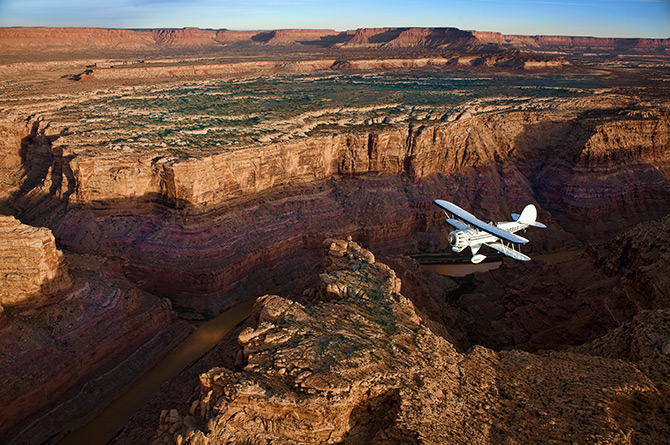Epic Flights: 88 magical aerial miles
A timeless aircraft flies in an ancient land
Photography by Chris Rose | Videography by Jim Clark
First light begins to raise night’s veil from the high desert. Myriad stars slowly fade as the sky turns from absolute black to a deep and unfathomable blue.
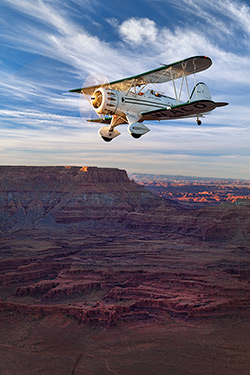
In the run-up area for Runway 21 at Canyonlands Field Airport in Moab, Utah, I shield my face behind a nylon mask and drop my seat down as low as possible while the Waco YMF–5D’s slow-turning wood MT propeller sends cold desert air swirling through the open cockpit. This classic airplane’s baritone 300-horsepower Jacobs engine holds five gallons of oil, and warming it on this frosty 34-degree Fahrenheit November morning will take time.
“No need to hurry,” I keep reminding myself. “Conditions are just going to keep getting better.”
This is the fourth and final day of a dream assignment: ferrying a nostalgic-looking but thoroughly modern biplane from Frederick, Maryland, to AOPA Aviation Summit in Long Beach, California. The next leg—a short 88-nm hop from Moab to the Lake Powell area on the Utah/Arizona border—is the part I’ve most looked forward to since I began planning this journey 10 weeks prior.
The route simply follows the Colorado River as it winds through some of the most unusual, revealing, and awe-inspiring geography in North America. Several national parks and recreation areas including The Arches, Canyonlands, and Glen Canyon mark the way, though none are yet illuminated by the rising sun. A pair of outstanding, although completely different, general aviation airplanes will provide the dynamic aerial vantage points. AOPA photographer Chris Rose and noted videographer Jim Clark are riding with Recreational Aviation Foundation President John McKenna in his temporarily doorless Cessna 185, and I’m alone in the Waco.
 We’ve arranged to rendezvous at 7 a.m. over a private grass airfield just south of Moab.
We’ve arranged to rendezvous at 7 a.m. over a private grass airfield just south of Moab.
It’ll take about 10 minutes for the Waco to fly to our aerial meeting place. Even though I know I’ll get there earlier than everyone else, I can’t make myself stay on the ground any longer. I’m impatient to get into the sky before the sun comes up and get this long-anticipated flight under way. I raise my seat, click the microphone seven times on the unicom frequency to bring the runway lights to full brightness, line up with the centerline, advance the throttle, and feel the invigorating earthquake of acceleration as the biplane charges forward and rises from the 7,100-foot runway. At a field elevation of 4,557 feet, the normally aspirated engine makes considerably less power than it did nearer sea level on the East Coast, but this morning’s cold, dry air partially offsets the performance loss. I climb in a lazy circle over the airport before turning south and overflying the quirky, outdoor-oriented town of Moab on my way to meet the photo ship.
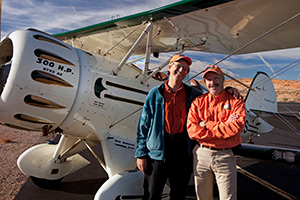 A thin layer of alto-cirrus clouds turns the shade of cotton candy in the gathering light, and the outlines of the wavy ground around Moab are barely discernable in the long shadow from Mount Peale, a 12,771-foot snow-covered peak to the southeast.
A thin layer of alto-cirrus clouds turns the shade of cotton candy in the gathering light, and the outlines of the wavy ground around Moab are barely discernable in the long shadow from Mount Peale, a 12,771-foot snow-covered peak to the southeast.
The biplane is jolted by sharp currents of air that eddy and tumble from their recent, rough interplay with the mountains. But my eyes (and the terrain view on the airplane’s Garmin GPSMAP 696) confirm I’m at a safe altitude, and as I continue climbing the wind aloft is mercifully light.
“Is that you, Dave?” asks McKenna, the 185 Skywagon pilot, using his handheld radio to call from the ground at the private airfield. “I can hear your engine. And I don’t imagine anyone else is flying a Waco over Moab this early.”
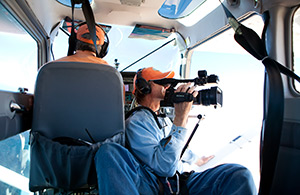 I circle above the grass airstrip as the three men clamber into McKenna’s Skywagon, taxi for departure, and launch into the serene morning sky. The Cessna is faster than the Waco. But with the Cessna climbing and carrying a heavy load and the Waco relatively light and at a higher altitude, I’m able to swoop down and move into position on the Skywagon’s right side without delay.
I circle above the grass airstrip as the three men clamber into McKenna’s Skywagon, taxi for departure, and launch into the serene morning sky. The Cessna is faster than the Waco. But with the Cessna climbing and carrying a heavy load and the Waco relatively light and at a higher altitude, I’m able to swoop down and move into position on the Skywagon’s right side without delay.
Golden light is beginning to reflect off the highest peaks to the southwest. The clarity of the air is such that the aptly named Orange Cliffs in Canyonlands National Park appear much closer than their actual distance of about 25 nautical miles, and we start flying toward them.
Rose is bundled against the cold, and the whipping wind tugs at the loose-fitting sleeves of his jacket. But I’m close enough to see that he’s smiling, too, as the conditions for aerial photography on this morning are absolutely ideal—and there’s no place that those of us fortunate enough to be part of this flight would rather be than right here, right now.
An ancient sea
The Arches National Park slides under my right wing, and from this high perch the place seems more theme park than natural wonder. The intricate sandstone arches are encircled by winding roads that bring visitors in cars to the foot of each one. The exotic shapes are known to just about anyone who has ever watched cowboy western movies (or Roadrunner cartoons), and the complex formations appear oddly artificial, even though they’re genuine.
The Colorado River is clear, slow moving, and relatively sedate near Moab, but it begins gaining speed as it winds through the steepening canyons downstream. A few miles to the southwest, a uranium mine is carved into the mountains on the west side of the river. The former rock walls were knocked down decades ago and made into terraced “evaporating ponds” to separate precious minerals from water.
Moab’s biggest population jump took place during the Cold War when the town marketed itself as the “uranium capital of the world.” Now, while mining continues, the place is better known as an outdoor sports magnet, especially for mountain-bikers, climbers, BASE jumpers, and off-road vehicle enthusiasts who come here from all over the world. (Canyonlands Field Airport has become an adventure center, too, with businesses offering skydiving, hot air balloon rides, and scenic flights.)
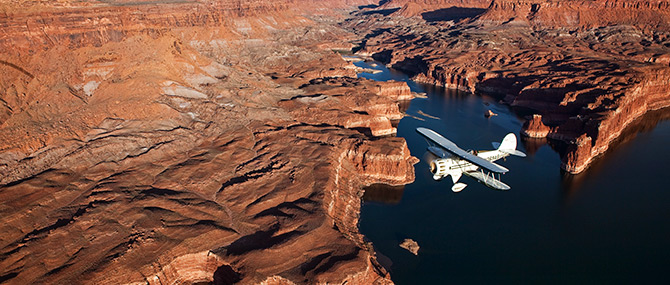
Arriving at the Orange Cliffs, we circle in formation and take in the wondrous scene. The Colorado and Green rivers meet here, and I’m surprised that the Green River appears larger in volume as it makes its way south from its origin in Wyoming.
The sun is well above the horizon now, and long, honey-colored shafts of light reveal rough contours on the valley floor. The rock walls that channel the Colorado River are steep and narrow downstream, and whitewater rages through Cataract Canyon a few miles below the place where the two bodies of water merge.
We fly more than 2,000 feet agl over the rushing water. But the river, despite its growing strength, seems tiny and inconsequential in the vastness of these magnificent surroundings. I try without success to comprehend the vast expanse of time it must have taken for this slim body of water to shape and define such immense and varied terrain. Mountains of red rock seem permanent, yet they’ve been molded, sculpted, and even washed away by a saltwater ocean—and this cutting, life-giving, band of cascading water.
We fly over Islands in the Sky, an area of flat-topped mesas, and cross into the Needles region of Canyonlands, so-called for the red-and-white banded rock pinnacles that rise from the rocky ground. This area is remote and nearly inaccessible by road or trail, but there are no such barriers to reaching it by air.
This place was once home to the Ancestral Puebloans, and remnants of their stone and mud dwellings and rock carvings are still here. Signs of human habitation date back several thousand years, but even that amount of time seems insignificant in this ancient land. Man’s 100-plus years of powered flight; AOPA’s 72-year history; and our own lifetimes are too paltry to register on such a scale.
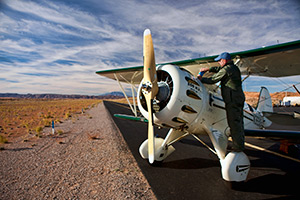 We continue flying south, loosely following the contours of the river, but ranging east and west to other areas, too.
We continue flying south, loosely following the contours of the river, but ranging east and west to other areas, too.
Soon we arrive over the Glen Canyon National Recreation Area and continue following the river as it slows and widens into Lake Powell, a massive reservoir formed by the Glen Canyon Dam. The houseboats that dot the lake each spring and summer are gone for the season, and the cold water dissuades skiers, too.
We’ve been aloft for nearly two hours on our rambling, circling, sometimes backtracking aerial tour, and it’s time to land, refuel, swap passengers, and go our separate ways. McKenna heads for Cal Black Memorial Airport (U96) at Halls Crossing in extreme southern Utah, and I follow him to a landing on Runway 18.
The morning chill is gone, and it feels great to remove my jacket and gloves and soak in the radiant warmth.
For a flatlander like me, the flight was like an out-of-body experience. Maneuvering the familiar and responsive biplane was second nature and required little conscious thought. But with the Colorado River at 3,800 feet msl and surrounding peaks reaching more than 12,000 feet, the snowy mountains, deep canyons, and rough-hewn rock formations appear so massive and so alien that flying among them is like taking a submarine tour of the ancient ocean that this region used to be.
Soon McKenna and Clark depart in the Skywagon bound for Salt Lake City where Clark will board an airliner, and then on to McKenna’s home in Montana. Rose and I climb back in the Waco and continue flying southwest to our bustling California destination.
The Grand Canyon, Meteor Crater, and the Los Angeles basin are still ahead of us—but nothing we’re likely to encounter can match the magical 88 miles we’ve just passed through.
E-mail the author at [email protected].
